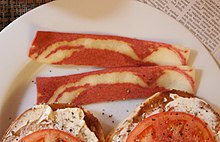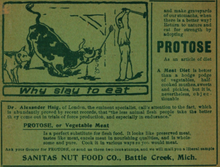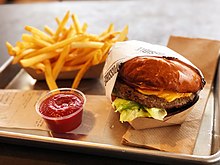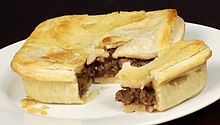Meat alternative



A meat alternative or meat substitute (also called plant-based meat or fake meat, sometimes pejoratively) is a food product made from vegetarian or vegan ingredients, eaten as a replacement for meat. Meat alternatives typically approximate qualities of specific types of meat, such as mouthfeel, flavor, appearance, or chemical characteristics. Plant- and fungus-based substitutes are frequently made with soy (e.g. tofu, tempeh, and textured vegetable protein), but may also be made from wheat gluten as in seitan, pea protein as in the Beyond Burger, or mycoprotein as in Quorn.
Meat alternatives are typically consumed as a source of dietary protein by vegetarians, vegans, and people following religious and cultural dietary laws. However, global demand for sustainable diets has also increased their popularity among non-vegetarians and flexitarians seeking to reduce the environmental impact of meat production.
Meat substitution has a long history. Tofu was invented in China as early as 200 BCE,[1] and in the Middle Ages, chopped nuts and grapes were used as a substitute for mincemeat during Lent.[2] Since the 2010s, startup companies such as Impossible Foods and Beyond Meat have popularized pre-made plant-based substitutes for ground beef, patties, and vegan chicken nuggets as commercial products.
History[]




Tofu, a meat alternative[failed verification] made from soybeans, was invented in China by the Han dynasty (206 BC–220 CE). Drawings of tofu production have been discovered in a Han dynasty tomb.[1][3] Its use as a meat alternative is recorded in a document written by Tao Gu (simplified Chinese: 陶谷; traditional Chinese: 陶穀; pinyin: Táo Gǔ, 903–970). Tao describes how tofu was popularly known as "small mutton" (Chinese: 小宰羊; pinyin: xiǎo zǎiyáng), which shows that the Chinese valued tofu as an imitation meat.[failed verification] Tofu was widely consumed during the Tang dynasty (618–907), and likely spread to Japan during the later Tang or early Song dynasty.[1]
In the third century CE, Athenaeus describes a preparation of mock anchovy in his work Deipnosophistae:[4]
He took a female turnip, shred it fine
Into the figure of the delicate fish;
Then did he pour on oil and savoury salt
With careful hand in due proportion.
On that he strew'd twelve grains of poppy seed,
Food which the Scythians love; then boil'd it all.
And when the turnip touch'd the royal lips,
Thus spake the king to the admiring guests:
"A cook is quite as useful as a poet,
And quite as wise, and these anchovies show it."
Wheat gluten has been documented in China since the sixth century.[5] The oldest reference to wheat gluten appears in the Qimin Yaoshu, a Chinese agricultural encyclopedia written by Jia Sixie in 535. The encyclopedia mentions noodles prepared from wheat gluten called bo duo.[5] Wheat gluten was known as mian jin by the Song dynasty (960–1279).
Prior to the arrival of Buddhism, northern China was predominantly a meat consuming culture. The vegetarian dietary laws of Buddhism led to development of meat substitutes as a replacement for the meat-based dishes that the Chinese were no longer able to consume as Buddhists. Meat alternatives such as tofu and wheat gluten are still associated with Buddhist cuisine in China and other parts of East Asia.[6] Meat alternatives were also popular in Medieval Europe during Lent, which prohibited the consumption of warm-blooded animals, eggs, and dairy products. Chopped almonds and grapes were used as a substitute for mincemeat. Diced bread was made into imitation cracklings and greaves.[2]
John Harvey Kellogg developed meat replacements variously from nuts, grains, and soy, starting around 1877, to feed patients in his vegetarian Battle Creek Sanitarium.[7] Kellogg's Sanitas Nut Food Company sold his meat substitute Protose, made from peanuts and wheat gluten. It became Kellogg's most popular product as several thousand tons had been consumed by 1930.[7]
There was an increased interest in meat substitutes during the late 19th century and first half of the 20th century.[8] Prior to 1950, interest in plant-based meat substitutes came from vegetarians searching for alternatives to meat protein for ethical reasons, and regular meat-eaters who were confronted with food shortages during World War I and World War II.[8]
Henrietta Latham Dwight authored a vegetarian cookbook, The Golden Age Cook-Book in 1898 which included meat substitute recipes such as a "mock chicken" recipe made from breadcrumbs, eggs, lemon juice and walnuts and a "mock clam soup" made from marrowfat beans and cream.[9] Dietitian Sarah Tyson Rorer authored the cookbook, Mrs. Rorer's Vegetable Cookery and Meat Substitutes in 1909.[9] The book includes a mock veal roast recipe made from lentils, breadcrumbs and peanuts.[9] In 1943, Kellogg made his first soy-based meat analog, called Soy Protose, which contained 32% soy.[7] In 1945, Mildred Lager commented that soybeans "are the best meat substitute from the vegetable kingdom, they will always be used to a great extent by the vegetarian in place of meat."[10]
In July 2016, Impossible Foods launched the Impossible Burger, a beef substitute which claims to offer appearance, taste and cooking properties similar to meat.[11] In April 2019, Burger King partnered with Impossible Foods to launch the plant-based Impossible Whopper, which was released nationwide later that year,[12] becoming one of the most successful product launches in Burger King's history.[13] By October 2019, restaurants, such as Carl's Jr, Hardee's, A&W, Dunkin Donuts, and KFC were selling plant-based meat products.[14] Nestlé entered the plant-based burger market in 2019 with the introduction of the "Awesome Burger".[15] Kellogg's Morningstar Farms brand tested its Incogmeato line of plant-based protein products in early September 2019, with plans for a US-wide rollout in early 2020.[16]
Types[]

Some vegetarian meat alternatives are based on centuries-old recipes for seitan (wheat gluten), rice, mushrooms, legumes, tempeh, yam flour or pressed-tofu, with flavoring added to make the finished product taste like chicken, beef, lamb, ham, sausage, seafood, etc. Other alternatives use modified defatted peanut flour, yuba and textured vegetable protein (TVP); yuba and TVP are both soy-based meat alternatives, the former made by layering the thin skin which forms on top of boiled soy milk,[17] and the latter being a dry bulk commodity derived from soy and soy protein concentrate. Some meat alternatives include mycoprotein, such as Quorn which usually uses egg white as a binder. Another type of single cell protein-based meat alternative (which does not use fungi however but rather bacteria[18]) is Calysta.
Production and composition[]
This section needs additional citations for verification. (January 2020) |
Meat analog products are currently made by two basic processes, through either thermoplastic extrusion or fiber spinning. Thermoplastic extrusion involves the adaptation of production processes that are more commonly associated with the making of ready-to-eat cereal products. Extruders are considered to be a cost-effective method of accommodating large-scale productions, and for forming desirable fibers.[19]
The types of ingredients that can be used to create meat substitutes is expanding, from companies like Plentify, which are using high-protein bacteria found in the human microbiome,[20] to companies like Meati Foods, that are cultivating the mycelium of fungi to form steaks, chicken breasts, or fish.[21]
Soy protein isolates or soybean flour and gluten are usually used as foundation for most meat substitutes that are available on the market. Soy protein isolate is a highly pure form of soy protein with a minimum protein content of 90%. The process of extracting the protein from the soybeans starts with the dehulling, or decortication, of the seeds. The seeds are then treated with solvents such as hexane to extract the oil from them. The oil-free soybean meal is then suspended in water and treated with alkali to dissolve the protein while leaving behind the carbohydrates. The alkaline solution is then treated with acidic substances to precipitate the protein, before being washed and dried. The removal of fats and carbohydrates, results in a product that has a relatively neutral flavor.[22] Soy protein is also considered a "complete protein" as it contains all of the essential amino acids that are crucial for proper human growth and development.[23]
Lipids are added to the meat analog in the form of liquid or semi-liquid glyceride shortening from synthesis, or other sources such as plants or animals. The glycerides could potentially contain unsaturated or saturated long-chain acyl radicals ranging from 12 to around 22 carbon atoms. Due to the target audience of meat alternatives, plant-based lipid sources such as soybean oil, olive oil, canola oil, and others alike are usually used.[24] While lipids do not contribute to the structure of the meat analog, it is crucial in increasing the palatability and broadening the appeal of the product across the consumer base.
Food additives include flavor compounds, coloring agents, leavening agents, and emulsifiers. Sodium bicarbonate is a commonly used leavening agent in a variety of baked products such as bread and pancakes. The carbon dioxide released by sodium bicarbonate aids in the expansion and the unilateral stretching of the protein network during production. A variety of emulsifiers can be used to stabilize the meat analog system. These could include, but are not limited to, polyglycerol monoesters of fatty acids, monoacylglycerol esters of dicarboxylic acids, sucrose monoesters of fatty acids, and phospholipids. Polyglycerol monoesters consist on average of 2 to 10 glycerol units and an average of one acyl fatty acid group per glycerol component. The polymer is created from esterification reactions with fatty acids and contains 14 to 16 carbons per polyglycerol moiety. Sucrose monoesters are derived from the esterification of sucrose with a fatty acid ester or a fatty acid and it ideally should have a fatty acyl group ranging from 14 to 18 carbon atoms. Lastly, phospholipid such as lecithin, cephalin, and sphingomyelin can also be used as effective emulsifiers.[24] In addition, some of the emulsifier act as a lubricant during the extrusion process.
Overall the composition of dry protein mix can contain between 30% to 100% water-hydratable, heat-coagulable protein by weight. A dry mix that contains 100% protein content yields the most desirable fibrous texture, but from the palatability standpoint between 50% to 70% was determined to generate the most positive feedback.[24]
Commerce[]
Meat substitutes represent around 11% of the world's meat and substitutes market in 2020. As shown in the graph, this market share is different from region to region.[25] From 2013 to 2021, the world average price of meat substitutes fell continuously, by an overall 33%. The only exception was a 0.3% increase in 2020, compared to 2019. The price will continue to decrease, according to projections by Statista (see average price graph).[26]
The motivation for seeking out meat substitutes varies among consumers. The market for meat alternatives is highly dependent on "meat-reducers", who are primarily motivated by health consciousness and weight management. Consumers who identify as vegan, vegetarian or pescetarian are more likely to endorse concerns regarding animal welfare and/or environmentalism as primary motivators.[28][29] Additionally, some cultural beliefs and religions place prohibitions on consuming some or all animal products, including Hinduism, Judaism, Islam, Christianity, Jainism, and Buddhism.
Vegan meats are consumed in restaurants, grocery stores, bakeries, vegan school meals, and in homes. The sector for plant-based meats grew by 37% in North America over 2017–18.[30] In 2018–19, sales of plant-based meats in the United States were $895 million,[31] with the global market for meat alternatives forecast to be $140 billion by 2029.[32] Seeking a healthy alternative to meat, curiosity, and trends toward veganism were drivers for the meat alternative market in 2019.[33] The book The End of Animal Farming by Jacy Reese Anthis argues that plant-based food and cultured meat will completely replace animal-based food by 2100.[34]
Environmental impact[]
Besides ethical and health motivations, developing better meat alternatives has the potential to reduce the environmental impact of meat production, an important concern given that the global demand for meat products is predicted to increase by 15 percent by 2031. Research on meats and no-meat substitutes suggests that no-meat products can offer substantial benefits over the production of beef, and to a lesser extent pork and chicken, in terms of greenhouse gas production, water and land use.[35] A 2022 report from the Boston Consulting Group found that, investment in improving and scaling up the production of meat and dairy alternatives leads to big greenhouse gas reductions compared with other investments.[36]
Criticism[]
Companies producing plant-based meat alternatives, including Beyond Meat and Impossible Foods, have been criticized for their marketing and makeup of their products as well as their use of animal testing.[37] Dietitians have claimed they are not necessarily healthier than meat due to their highly processed nature and sodium content.[38][39]
John Mackey, co-founder and CEO of Whole Foods, and Brian Niccol, CEO of Chipotle Mexican Grill, have criticized meat alternatives for being ultra-processed. Chipotle has claimed it will not carry these products at their restaurants due to their highly processed nature. According to CNBC, "Chipotle joins the likes of Taco Bell—Niccol's former employer—and Arby's in committing to excluding meatless meats on its menu."[40] In response, Beyond Meat invited Niccol to visit its manufacturing site to see the production process.[40] Chipotle later developed its own "plant-based chorizo".[41][42]
Some consulting firms and analysts demand more transparency in terms of the environmental impact of plant-based meat.[43]
Some states have instituted legislation stating that meat alternatives are not allowed to label themselves as "meat". In Louisiana, the so-called, "Truth in Labeling of Food Products Act” was challenged by Tofurkey, complaining of free speech violations[44] and was successful on those grounds.[45]
See also[]
- Vegetarian bacon
- Vegetarian hot dogs
- Vegetarian sausage
- Meat-free sausage roll
- Soy curls – Soy based meat alternative
- Cultured meat – Animal flesh product that has never been part of a living animal
- Egg substitutes – Food products which can be used to replace eggs in cooking and baking
- Insects as food – Use of insects as food for humans
- List of bacon substitutes
- List of meat substitutes
- List of vegetarian and vegan companies
- Leghemoglobin: alters flavor of certain meat alternatives to make them taste even more similar to meat ("simulates" animal blood in these meat alternatives but made from plant-based sources)
- Milk substitute – Alternative substance that resembles milk
- Single-cell protein, meat alternatives containing protein extract from pure or mixed cultures of algae, yeasts, fungi, or bacteria or made from air
- Timeline of cellular agriculture
References[]
- ^ Jump up to: a b c DuBois, Christine; Tan, Chee-Beng; Mintz, Sidney (2008). The World of Soy. National University of Singapore Press. pp. 101–102. ISBN 978-9971-69-413-5.
- ^ Jump up to: a b Adamson, Melitta Weiss (2004). Food in Medieval Times. Greenwood Publishing Group. p. 72. ISBN 978-0-313-32147-4.
- ^ William Shurtleff; Akiko Aoyagi (18 December 2014). History of Meat Alternatives (965 CE to 2014): Extensively Annotated Bibliography and Sourcebook (PDF). Soyinfo Center. ISBN 978-1-928914-71-6.
- ^ Athenaeus. Deipnosophistae. Project Gutenberg. p. 11.
- ^ Jump up to: a b Shurtleff, William; Aoyagi, Akiko; Huang, H.T. (2014). History of Soybeans and Soyfoods in China and Taiwan, and in Chinese Cookbooks, Restaurants, and Chinese Work with Soyfoods Outside China (1024 BCE to 2014). Soyinfo Center. pp. 2478–2479. ISBN 978-1-928914-68-6.
- ^ Anderson, E.N. (2014). "China". Food in Time and Place. University of California Press. p. 44. ISBN 978-0-520-95934-7.
- ^ Jump up to: a b c "Dr. John Harvey Kellogg and Battle Creek Foods". www.soyinfocenter.com.
- ^ Jump up to: a b Perren, Richard. (2017). Taste, Trade and Technology: The Development of the International Meat Industry Since 1840. Routledge. pp. 188-190. ISBN 978-0-7546-3648-9
- ^ Jump up to: a b c Shprintzen, Adam D. (2013). The Vegetarian Crusade: The Rise of an American Reform Movement, 1817-1921. University of North Carolina Press. pp. 137-138. ISBN 978-1-4696-0891-4
- ^ Lager, Mildred M. (1945). The Useful Soybean: A Plus Factor in Modern Living. McGraw-Hill Book Company. p. 95
- ^ Reilly, Michael (22 June 2016). "Fake meat companies might finally cure our addiction to animal flesh". Technology Review. Retrieved 28 July 2016.
- ^ Popper, Nathaniel (1 April 2019). "Behold the Beefless 'Impossible Whopper'". The New York Times. Retrieved 3 April 2019.
- ^ Chiorando, Marie (17 November 2019). "Impossible Whopper Is 'One Of Burger King's Most Successful Launches In History'". www.plantbasednews.org. Retrieved 7 February 2020.
- ^ Rivera, Dane (22 October 2019). "All The Major Fast Food Chains And Markets Selling Beyond Meat and Impossible Foods". Uproxx. Retrieved 10 January 2020.
- ^ Wiener-Bronner, Danielle (24 September 2019). "The Awesome Burger is Nestlé's answer to the plant-based meat craze". CNN Business. Cable News Network. Retrieved 7 February 2020.
- ^ Chung, Heidi (12 February 2020). "Food giant Kellogg's unveils 'Incogmeato' plant-based products". Yahoo! Finance.
- ^ Patterson, Daniel (6 August 2006). "The Way We Eat: I Can't Believe It's Tofu". The New York Times. Retrieved 26 February 2009.
- ^ EOS, April 2019, page 52
- ^ Alam, M. S.; Kaur, Jasmeen; Khaira, Harjot; Gupta, Kalika (9 January 2015). "Extrusion and Extruded Products: Changes in Quality Attributes as Affected by Extrusion Process Parameters: A Review". Critical Reviews in Food Science and Nutrition. 56 (3): 445–473. doi:10.1080/10408398.2013.779568. ISSN 1040-8398. PMID 25574813. S2CID 46127447.
- ^ Watson, Elaine (20 June 2020). "'Plentify' novel single cell protein 'ludicrously efficient' to produce vs animal protein, claims startup". Retrieved 26 June 2020.
- ^ Peters, Adele (29 October 2019). "If it looks like a steak and tastes like a steak, in this case, it's a mushroom". Fast Company. Retrieved 26 June 2020.
- ^ Sedgwick, Tali (28 June 2013). "Meat Analogs". Food and Nutrition. Academy of Nutrition and Dietetics. Retrieved 10 December 2016.
- ^ US patent US2682466A High protein food product and process for its preparation Robert A. Boyer, published 29 June 1954 US patent 5285709, "Meat Analog Compositions." Robert A. Boyer, issued 29 June 1954
- ^ Jump up to: a b c US patent 3814823, Yang J. and R. Olsen, "Meat Analogs Having the Fiber Structure of Meat.", issued 4 June 1974
- ^ Jump up to: a b "Uprooting tradition: What plant-based alternatives mean for the future of protein". Royal Bank of Canada. 21 May 2021. pp. 13–14. Archived from the original on 30 January 2022. Retrieved 30 January 2022. Formula: (Retail value meat substitutes) / (Retail value meat + retail value meat substitutes).
- ^ Jump up to: a b "Global: meat substitute price per unit 2013–2026". Statista. November 2021. Retrieved 29 January 2022.
all types of meat-like products that approximate certain aesthetic qualities (primarily texture, flavor, and appearance) or chemical characteristics of a specific meat. (...) includes plant-based meat and vegetarian meat [which] contains non-vegan ingredients
- ^ "Meat Substitutes – Worldwide | Statista Market Forecast". Statista. Retrieved 29 January 2022.
- ^ "CONSUMER INSIGHTS" (PDF). AHDB. July 2018. Retrieved 2 September 2020.
- ^ Penny, J. C.; Swift, J. A.; Salter, A. M. (2015). "'Meat reducers': meat reduction strategies and attitudes towards meat alternatives in an emerging group". Proceedings of the Nutrition Society. 74 (OCE5). doi:10.1017/S0029665115003602. ISSN 0029-6651.
- ^ Olayanju, Julia B. (30 July 2019). "Plant-based Meat Alternatives: Perspectives On Consumer Demands And Future Directions". Forbes. Retrieved 10 January 2020.
- ^ Cheng, Andria (29 July 2019). "Beyond Meat Q2 Sales Quadruple, But Replacing Meat? That's A Different Story". Forbes. Retrieved 10 January 2020.
- ^ Franck, Thomas (23 May 2019). "Alternative meat to become $140 billion industry in a decade, Barclays predicts". CNBC. Retrieved 10 January 2020.
- ^ Mourdoukoutas, Panos (31 August 2019). "Veganism And Vegetarianism Are Changing Fast Food". Forbes. Retrieved 10 January 2020.
- ^ Reese, Jacy (6 November 2018). The End of Animal Farming: How Scientists, Entrepreneurs, and Activists are Building an Animal-Free Food System. Boston: Beacon Press. ISBN 9780807039878.
- ^ Holmes, Bob (20 July 2022). "How sustainable are fake meats?". Knowable Magazine. doi:10.1146/knowable-071922-1. Retrieved 1 August 2022.
- ^ Carrington, Damian (7 July 2022). "Plant-based meat by far the best climate investment, report finds". The Guardian. Retrieved 10 July 2022.
- ^ "Why It's Impossible for PETA to Get Behind the Impossible Burger". Archived from the original on 27 July 2018.
- ^ Lucas, Amelia (4 July 2019). "Are Beyond Meat's plant-based burgers healthier than red meat? Dietitians say no". CNBC. Retrieved 2 September 2020.
- ^ Drayer, Lisa (2019). "They might be better for the planet, but are plant-based burgers good for you?". CNN Health. Retrieved 2 September 2020.
- ^ Jump up to: a b Lucas, Amelia (24 July 2019). "Beyond Meat CEO invites Chipotle for a tour after its fake meats are called too processed". CNBC. Retrieved 2 September 2020.
- ^ Lucas, Amelia (19 August 2021). "Chipotle is testing a meatless chorizo alternative in two markets". CNBC. Retrieved 25 August 2020.
- ^ Lucas, Amelia (3 January 2022). "Chipotle adds meatless chorizo to its menu for limited time". CNBC. Retrieved 3 January 2022.
- ^ Creswell, Julie (15 October 2021). "Plant-Based Food Companies Face Critics: Environmental Advocates". The New York Times. ISSN 0362-4331. Retrieved 8 November 2021.
- ^ "Pickin' on Veggies: Louisiana's "Truth in Labeling of Food Products Act"". 22 January 2020.
- ^ "Veggie 'Meat' Maker Tofurky Wins Free Speech Challenge to Food-Labeling Law". 31 March 2022.
Further reading[]
- Yes, plant-based meat is better for the planet. Vox. 18 November 2021.
- Meat substitutes
- American inventions
- Buddhist cuisine
- Chinese inventions
- Imitation foods
- Lent
- Vegetarian cuisine